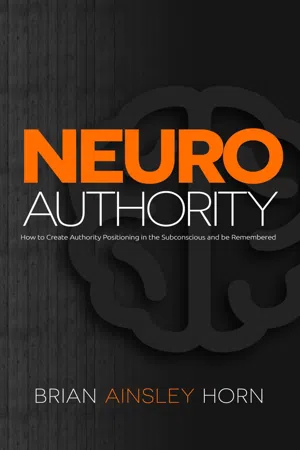
NeuroAuthority
How to Create Authority Positioning in the Subconscious and be Remembered
- English
- ePUB (mobile friendly)
- Available on iOS & Android
NeuroAuthority
How to Create Authority Positioning in the Subconscious and be Remembered
About This Book
What is “NeuroAuthority” anyway? At a high level, it’s the combination of neuroscience and authority marketing.
Neuromarketing is a new field of marketing research that studies consumers’ sensorimotor, cognitive, and affective response to marketing stimuli. The technology is based on a model whereby the major thinking part of human activity (over 90%), including emotion, takes place in the subconscious area that is below the levels of controlled awareness.
Authority marketing helps entrepreneurs leverage their knowledge to gain authority status in their industry. This authority status then allows them to dramatically amplify their message and convert their new audience into higher paying customers. In other words, it’s the process for positioning yourself as an authority, or even a celebrity, in your marketplace.
NeuroAuthority is the science of creating authority positioning in the subconscious area that is below the levels of controlled awareness. It’s using the proven tools of neuroscience to determine why we deem one person as an “expert” over another and then applying the research so you can use it to get more clients.
Traditional methods used by marketers won’t trigger decisions at a subconscious level. They just use whatever the “shiny button” is at the moment, and hope that it will work. Instead, they should use a scientific approach to capture insights that predict why prospects will choose to follow, respect, and eventually buy from one person over another.
In his latest book, Best Selling Author and Entrepreneur, Brian Ainsley Horn reveals the concept of NeuroAuthority and uses case studies to back up his findings. He also provides actionable applications of it for entrepreneurs, small business owners, and professionals.
Frequently asked questions
Information
START A PODCAST
Step 1: Choose a Good Topic
Step 2: Select a Format
- What will the format for your show look like?
- Will you host a show and interview an “expert” on a topic?
- Will you be the expert who provides content?
- Will you have one or two hosts?
- How long will each of your episodes be?
- How frequently will you post new episodes?
- Do you want a weekly podcast, daily or something entirely different?
- Will your show be an audio podcast or video format?
- What will they enjoy the most?
- Are they busy professionals who prefer short episodes?
- Would they actually to listen to a 40-minute podcast?
Step 3: Buy Equipment
- A good microphone: You don’t have to invest in the best quality microphone on the market, but your audience does need to be able to hear you clearly. It’s a good idea to avoid built-in microphones that come with a computer. We recommend Blue Microphones Yeti USB or Audio Technica ATR-2100-USB.
- Headphones: Again, these don’t have to be the best out there, but good headphones are helpful. You need to be able to hear yourself and hear what your guests are saying. It’s a good idea to stick with the on-the-ear type. Audio-Technica ATH-M30x is a good example. Avoid headphone/mic combos in general.
- Pop filter: When you talk directly into a microphone, your p’s and b’s will be amplified. So, you can either speak into the side of the mic, or get a pop filter.
- Boom: This isn’t something you need when first starting out, but it can be helpful down the road. A suspension boom takes your podcast up a notch. It simply holds the mic for you, which ensures consistent, high-quality sound.
- Skype Account: You will almost certainly need to use Skype at some point when hosting a podcast. Skype gives you an easy way to interview guests, and the sound quality is excellent, making it a preferred program by many podcast pros.
- Editing and Recording Software: Adobe Audition and GarageBand are two free editing and recording programs you can use. Auphonic is Jack’s personal choice for our show. You will need a way to edit your audio when creating a podcast. So, some sort of recording and editing software is a must.
- ID3 Editor: The ID3 editor, allows you to store important information like track numbers, artists and the like. It will even appear like album art. By using this software, you give your podcast a more professional appearance.
- Vanity URL: One way to grow your podcast following is to make it as easy as possible for listeners to leave reviews. To do this, secure a vanity URL. They are used to redirect the podcast review section on iTunes. You won’t have to worry about giving out a complicated website address when you get a vanity URL. It will just make things easier for your listeners.
Step 4: Set Up Podcast Hosting
Step 5: Choose a Good Title
Table of contents
- Title Page
- UNDERSTANDING NEUROAUTHORITY
- MICROSPECIALIZATION
- CREATING A COOL PERSONAL BRAND
- STORYBRANDING
- BE REMEMBERED
- DESTROYING THE FOUNDATION
- INCREASE WEBSITE ENGAGEMENT
- AUTHORITY CONTENT MARKETING
- CREATING BRAND LOYALTY
- BUILDING A SALES FUNNEL
- GET SPEAKING GIGS WITH AUTHORITY MARKETING
- GET MEDIA COVERAGE
- START A PODCAST
- WIN CUSTOMERS BACK WITH AUTHORITY
- SIMPLE MARKET INFLUENCE BOOK
- NEXT STEP